What's in the box this week~~~~~~~~~~~~~~~~~~~~~~~~~~~~~~~~~~~~~~~~~~~~~~~~
Content differences between Family and
Small shares are in red; items with a
"+" in one size share are more in quantity than in the other. For any items
not from our farm, we will identify the source in parentheses. Occasionally content will differ
from this list (typically we make a substitution), but we do our best to
give you an accurate projection.
Family Share
Purple basil
Broccoli
Carrots
Cilantro
Collards
Escarole
Lacinato kale
Red Russian kale
Lettuce
Bunching onions
Red potatoes
Summer squash
Strawberries
Small Share
Broccoli
Napa cabbage
Carrots
Cilantro
Collards
Kale (Red Russian OR Lacinato)
Lettuce
Bunching onions
Red potatoes
Strawberries
Bread Option
This week's bread will be three-seed whole wheat
Extra Fruit
3 baskets of Strawberries
1 basket of raspberries or blackberries
Fruit Bounty is 'on' this week (floating week #8 of 15)
3 baskets of Strawberries
1 basket of raspberries or blackberries
|
The Farm as a Learning Resource
~~~~~~~~~~~~~~~~~~~~~~~~~~~~~~~~~~~~~~~~~~~~~~~~ When I first started thinking about farming on my own (17 years ago), it was the experience of meeting farmers and working side-by-side with them that inspired me - and our then still young family (David was just born) - to leave the city (San Francisco) and start farming. Today I see this trend growing stronger. More people are making conscious health and lifestyle choices that strengthen local food and farming efforts. In turn, these efforts are attracting the interest of younger people to engage in careers in sustainable farming. The potential future opportunities for this next generation of young farmers seems promising given the increased demand for local and organic food. Today only 2% of the population is engaged in farming, and 45% of farmers are over the age of 45. Although large scale commercial farms will continue to be important in the overall food production business, the real action, where skilled farmers will be needed most, is in small scale food production systems sprouting up in and around urban centers. The challenges are numerous, but I think there is an exciting future out there for young dedicated people who want to own and operate their own organic farms. New farmers understand that they need to make money, but they also understand that they need to be good friends, good neighbors, and good citizens. They also understand that farmers are the caretakers of the earth and that their stewardship of the earth matters for the future of humanity. New farmers understand that the purpose of real farming is far more important than just production and profits. If the promise of a more environmentally sound economy is to be fulfilled, it is our responsibility to reach out to these young people. 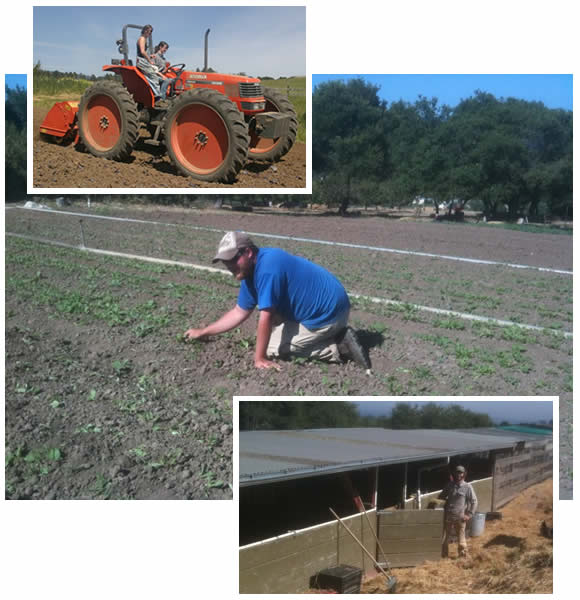 [Taylor and Molly tractoring; Jeff weeding beets; David E. doing animal care]
Our son David, who has just turned 16, is also working on the farm for a few weeks this summer. Of course he is mostly motivated by the opportunity to earn some spending money and drive dad's truck around the farm, but I also see he's interested in better understanding what motivates our team of young farm-journeymen; what compels them to get up early and work so hard everyday in the field, whether it's weeding, trellising beans, harvesting, going to farmer's markets, planting, picking flowers, watering, building chicken nest boxes, or taking care of the animals. 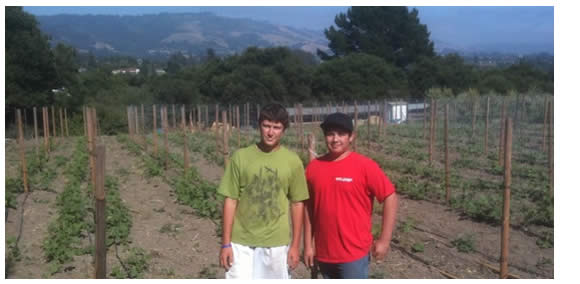 [son David Broz, left, and a friend, pause for photo op while trellising green beans] [son David Broz, left, and a friend, pause for photo op while trellising green beans]I am grateful for, and personally enjoy working with our highly motivated and hard working team of interns here on the farm this season. Since I run out of "inspirational steam" at times writing the weekly newsletter, I always encourage our interns (in their spare time) to share their own stories. So below, Molly describes last Saturday's lamb butchering workshop, providing a glimpse into a very unique and powerful "pasture to food" experience, especially for a beginning farmer who still needs to decide what kind of farming system she want to embrace. Experiencing what life is really like on a working farm is critical to putting perspective on any idealized notions about farming, and helps our interns to explore and be clear about their real motivations. This farm is a resource for building and nourishing diverse relationships among all members of our community, but in particular, we especially like to inspire youth about professional opportunities and lifestyles associated with building sustainable food systems. If you are interested in supporting or learning more about our educational efforts, I encourage you to look into Live Earth Farm's Discovery Program. Read more about our activities and programs or make a donation through the farm's website www.liveearthfarm.net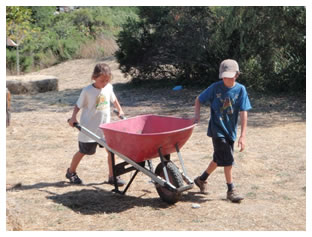 - Tom
|
Lamb Processing Workshop - a Unique Experience
~~~~~~~~~~~~~~~~~~~~~~~~~~~~~~~~~~~~~~~~~~~~~~~~
(Please
pardon in advance any seemingly blunt vocabulary in this story; if you are a
meat eater, you must accept that at some point a life must be taken in order to
have meat as food; nevertheless, it is difficult to find words that encapsulate
the act more gently. If you are at all squeamish, you may want to skip this
story. - Molly)
Last
Saturday, a diverse group of 12 people came to the farm for a rare and special
experience - to learn how to slaughter and butcher a lamb. I organized this
event as an educational workshop, for people genuinely interested in
understanding what is involved in humanely taking the life of an animal, and in
learning how to process the animal afterwards. I was amazed at the degree of interest;
I received immediate responses from aspiring farmers, amateur cooks, and local
food enthusiasts alike who all shared a desire to demystify this aspect of our
food chain.
Live
Earth Farm has been home to 17 sheep - 6 ewes and 11 lambs - since January. Our sheep are a mix of Hampshire and
Suffolk breeds, breeds primarily raised for wool and meat. We plan to keep the
4 female lambs; the males will either be slaughtered or sold.
Leon
Vehaba, farm manager at Everett Family Farms, and his father, Dror Vehaba, a
professional butcher with 30 years of experience, led the workshop. Dror was
raised on a kibbutz in Israel, where he grew up immersed in agricultural life. Both plant and animal care were part of his daily chores. He now works the butcher's counter at a privately run grocery store. In his years behind that counter, he has
witnessed the evolution of Americans' needs and interests when it comes to
buying meat. "I am seeing more and more young people looking for organic meat. 'Natural'
doesn't mean anything. They know that. And they will pay a higher price," he says.
This was
my second experience at a lamb slaughter, and in both instances, the slaughter
was performed on a farm, not very far from the pasture where the animal was
born and raised. "It is very important," Leon explained, "that we create as calm
an environment as possible for the animal." We brought the lamb to a shady spot
under a large oak tree, and fed him alfalfa, and he did seem very relaxed. To
slaughter him, he was laid on his back and, as predicted, he surrendered. Most
animals will not resist once in this submissive position. Leon also explained
how important it is that a knife be very sharp, so that the act of cutting the
throat is a one-motion action. We were all very quiet as the lamb left our
world; I believe he went as quickly and painlessly as possible. There was
certainly a profound aura of respect and gratitude for his life from all
present.
From
there, we hung the carcass, and proceeded to skin and gut it. The first step was to pump air into the
cavity so that the hide separates from the muscle - this helps one to cut
cleanly, and avoid puncturing meat, muscle or vital organs. It was fascinating to see the vital
organs and learn from Dror all of the uses for every part of the animal. "Nothing
should be wasted, everything can be used," he says.
We then
moved inside our new breezeway kitchen to learn the butchering process. Dror
led a very hands-on explanation of the techniques and tools necessary for
cutting meat - from where to begin and where all of the prime cuts were. He
also explained all of the uses for the various cuts, and how to store them.
I found the workshop to be extremely educational
and moving. We learned the skills, mindset and environment needed for animal
slaughter and butchering. We were very lucky to have Dror and Leon with us, as
they both brought much knowledge and wisdom to the process. I was in particular
touched by the dynamic between father in son; it somehow gave the event the
feel more common in other parts of the world, where animal slaughter is a
ritual aspect of community, rather than hidden from us in an industry far
removed from community. There was a true spirit of connection throughout the
day - a sense that everyone wanted to be present and connected with their food
source. So many of us these days are completely out of touch with the process
which brings us the meat that winds up on our dinner plates. I would encourage
anyone who has the interest to attend such a workshop. We may have more in the
future, so stay tuned!- Molly Culver |
Surfside Chickens now delivering to the South Bay
~~~~~~~~~~~~~~~~~~~~~~~~~~~~~~~~~~~~~~~~~~~~~~~~ 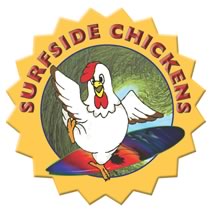 You heard that right: in addition to their sites in Watsonville and Santa Cruz, Surfside Chickens has a new pick-up spot "over the hill" in the Willow Glen area of San Jose (vicinity of Lincoln and Broadway - easy access from Hwy 280). Sarah Greene raises all her chickens on pasture (supplementing their diet with organic grains). They live their lives on green grass and get to roam about; no cages here! In Sarah's own words, "We raise organically fed, pastured chickens, and harvest with gratitude
for the sacrifice each chicken makes to become food for our tables."  Sarah and her partner Aurelio harvest every other week. The next delivery day will be Monday July 12th (and pick-up time is not restricted; you can pick up any time from around 11am through Noon the following day, so people who need to pick up before or after work should not have a problem). Call or email Sarah with your orders (i.e. how many chickens you want - average size is 3.5 lbs) by the Friday before delivery day (birds are harvested on Saturdays) and then she will give you the address and any remaining instructions. The average bird will be $15 - $20, and you can get 3 to 4 meals for two people out of each chicken. See Surfside Chicken's facebook page for pictures and more info. phone: 217.412.7374 email: surfsidechickens@gmail.com |
Art on the Farm Adventure Day Camp - a few spots left!
~~~~~~~~~~~~~~~~~~~~~~~~~~~~~~~~~~~~~~~~~~~~~~~~ Last call for signing up for this special weeklong adventure day camp, here on the farm, July 12th - 16th! Contact Taylor Brady at vermontaylor@gmail.com or call the LEF Discovery Program
office at (831) 728-2032.What will the experience be? Kids can
expect to get their hands dirty while exploring pieces of Live Earth's 80 acres
in both organic vegetable row crop production and fruit orchards. In addition
to learning about life as an organic vegetable farmer, they will spend time
getting to know our herd of goats, our flock of sheep and visit with chickens. They will assist in daily chores of our animals while learning about the
benefits of humane livestock management. 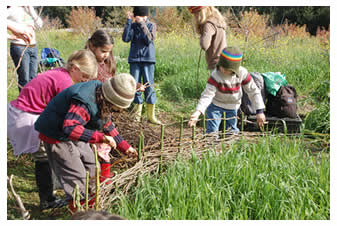 Throughout
the week kids can also expect to explore the wonders of the farm while
creatively expressing their interpretation of the natural world through the
visual arts. Activities will include printing from natural materials, fort
making, working in the education demonstration garden, animal spirit
mask-making and so much more! Each day we will harvest something from the
garden to contribute to our sustainable lunch picnics! We are limiting
participation to 20 kids between the ages of 8 and 12, so sign up today, we still have a few openings! Throughout
the week kids can also expect to explore the wonders of the farm while
creatively expressing their interpretation of the natural world through the
visual arts. Activities will include printing from natural materials, fort
making, working in the education demonstration garden, animal spirit
mask-making and so much more! Each day we will harvest something from the
garden to contribute to our sustainable lunch picnics! We are limiting
participation to 20 kids between the ages of 8 and 12, so sign up today, we still have a few openings!
Although this will be a day-camp affair, we are also offering an optional Thursday night pizza-making camp-out and sleepover! This option is for kids
who wish to carry the fun of daily farm life long into the night. Join us for
cob oven baking, s'mores making, and a roaring fire. There is an additional
cost for those who choose to do the overnight, but the cost covers a farm
fresh dinner, and breakfast in the morning. Don't forget your sleeping bag! Details Age: 8 - 12 Cost
· $325/camper for the full week (not including Thursday sleepover). Cost includes
plenty of art supplies and a daily farm-fresh snack!
· There is an extra charge of $50/camper for the Thursday night sleepover.
· We are also offering two partial scholarships to those most needed. Please contact
us if interested.
Hours: 9am - 4pm Mon - Fri, plus the optional Thursday night camp-out sleepover.
Dates: July 12th - 16th |
Debbie's Kitchen is back!~~~~~~~~~~~~~~~~~~~~~~~~~~~~~~~~~~~~~~~~~~~~~~~~ Click here to go to the recipe database.Bon Giorno everyone it is good to be home. Although I was traveling and eating in the heart of Slow Food country (northern Italy, and a bit of the Alsace region of Germany, France and Switzerland), I was quite surprised by the relative lack of green veggies at mealtimes; meat, cheeses, pasta, bread and sweets (and wine!) were all delicious and in ample supply, but fresh fruit and vegetables, especially green veggies, were rarely in evidence. My experience simply reminded me how grateful I am to live in a region where fresh and beautiful produce is so readily available. At one dinner we were served what was clearly a 'treat' of fresh fruit... and guess what it was? Strawberries! Again, we are so very fortunate to have the bounty we have here in the Bay Area, and for such an extended growing period. I have always known this, of course, but my (first ever) trip to Europe left no doubts in my mind.
One message that was clearly evident, however, was that sharing food around a table with family and friends is an integral part of daily life. This was a great joy for me, because it is something I have always valued highly. Dinners were always convivial and long... and absolutely delightful! At the agriturismo where we stayed, all guests sat around a long table and shared whatever our host prepared for the evening. (On the evening pictured below, it was a sumptuous risotto!)
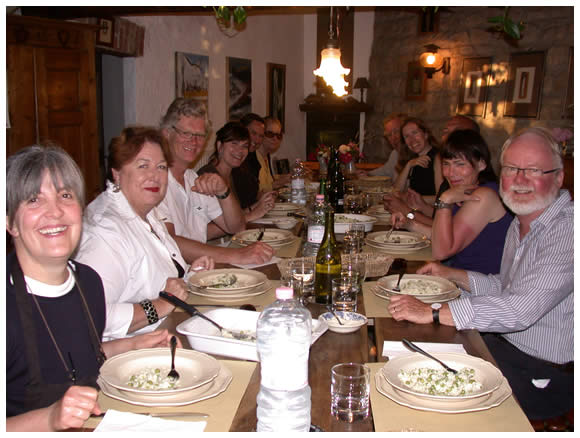
Enough with reminiscing though, it is time to roll out a few new recipes! - Debbie
. . . . . . . . . . . . . . .
On making potato salads
I see that potatoes made their first appearance while I was away, so one thing I'd like to talk about this week is potato salads. To me, the most flavorful potato salads all have a trick in common -- you bake, boil or steam the potatoes, then cut them up and, while they're still warm, toss them with vinegar or vinaigrette, then add the rest of the ingredients. The potatoes absorb the flavors this way, and it is much more yummy than a salad made from cold cooked potatoes and mayonnaise. I also like how potato salads can be enjoyed warm, room temperature, or cold. Anyway, once you learn this trick, you can experiment! Try different vinegars and veggies. You can still fold in mayonnaise or other interesting sauces, but don't leave out the dressing-potatoes-while-warm step!
What kind of things from this week's box might I put into a potato salad? There's the purple basil, there's cilantro, there's the delicate bunching onions (which you can either mince up and use the white bulb, or the green stems -- or both), escarole would be nice, as would diced up bits of summer squash; if you have radishes from the prior week, they're a great addition for texture and color (as are bok choi and mei qing choi, when we have those). If you still have arugula from last week, that is also a great addition.
You can also add bacon or bits of sausage or cured meats, or a little anchovy, or egg, or cheese, or olives, or pickles, or capers, or even nuts or dried fruit, depending on the flavor combination you're after. You can also play with herbs and spices like cumin or curry powder, fresh mint or thyme or... gosh, there are so many things; the possibilities are nearly endless!
Here's how I'll probably make a potato salad this week though, based on what's in the box:
Week 14 Potato Salad (Family Share)Potatoes Escarole Summer Squash Onion Purple Basil Red wine vinegar Olive oil Salt and pepper (Mayonnaise optional) Lettuce for serving Steam, boil or bake potatoes whole, skins on, until just done. While potatoes are cooking, prepare veggies: dice up some summer squash, shred some escarole, mince some bunching onions (white and green parts both), and chop up a bunch of purple basil. Make a vinaigrette from vinegar and olive oil, salt and
pepper -- or 'enhance' mayonnaise with vinegar, oil, S&P -- and have everything standing by. Once potatoes are done, cool until you can handle them, then cut into quarters, then crosswise into slices. While still warm, sprinkle and toss potatoes with red wine vinegar (unpasteurized/raw is best) -- as much as a half-teaspoon per potato, but I don't measure. Then fold in prepared veggies and herbs, and additional dressing and toss to combine. Taste and adjust salt and pepper if needed, then serve room temperature or refrigerate and serve cold, on a bed of lettuce. Week 14 Potato Salad (Small Share)Potatoes Napa cabbage Onion Cilantro Cider vinegar and/or a combo of cider vinegar and lemon juice Olive oil Cumin Salt and pepper (Mayonnaise optional) Lettuce for serving Steam, boil or bake potatoes whole, skins on, until just done. While
potatoes are cooking, prepare veggies: shred
some Napa cabbage, mince some bunching onions (white and green parts both),
and chop up a bunch of cilantro. Make a vinaigrette
from vinegar/lemon juice and olive oil, cumin, salt and
pepper -- or 'enhance' mayonnaise with vinegar (lemon), oil, cumin, S&P -- and have
everything standing by. Once potatoes are done, cool until you
can handle them, then cut into quarters, then crosswise into slices.
While still warm, sprinkle and toss potatoes with cider vinegar
(unpasteurized/raw is best) -- as much as a half-teaspoon per potato,
but I don't measure. Then fold in prepared veggies and herbs, and
additional dressing and toss to combine. Taste and adjust salt and
pepper if needed, then serve room temperature or refrigerate and serve
cold, on a bed of lettuce.
Here is a broccoli recipe sent to me by member Elke Billingsley, who said, "using last week's broccoli (the entire bag), sausage from our pig half from TLC Ranch, scallions from the bag, jarred tomatoes from our winter share, thyme from our garden... this was a useful, tasty, summery recipe!" The photo is Elke's, from her own preparation.
Orecchiette with Sausage, Broccoli, and Caramelized GarlicFrom www.seriouseats.com; adapted from a recipe in the New York Times Serves 4 12 oz. broccoli florets (from about 2 average-sized bunches), cut
into bite-sized pieces
4 tbsp. olive oil
3/4 lb. sweet Italian sausage, casings removed
3/4 lb. orecchiette pasta, or substitute another short pasta such as
penne
4 cloves garlic, peeled and sliced
Salt to taste
8 oil-packed sun-dried tomatoes, sliced
1 tbsp. fresh thyme leaves, roughly chopped
Juice of half a lemon
1/4 C Parmesan cheese
3 scallions, both white and light green parts, thinly sliced 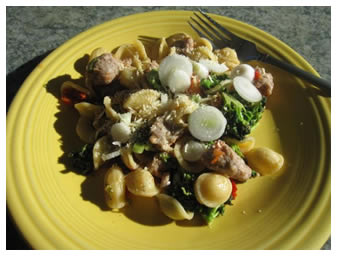 Bring a large pot of salty water to boil and
prepare a bowl of ice water. Drop the broccoli into boiling water and
cook until tender but still slightly firm, 2-3 minutes. Transfer the
broccoli with a slotted spoon to the ice bath to cool quickly. Stir
until cool, then drain the water. Return the water to a boil and cook
the pasta until al dente, reserving 1 cup of the pasta cooking water
before draining. Bring a large pot of salty water to boil and
prepare a bowl of ice water. Drop the broccoli into boiling water and
cook until tender but still slightly firm, 2-3 minutes. Transfer the
broccoli with a slotted spoon to the ice bath to cool quickly. Stir
until cool, then drain the water. Return the water to a boil and cook
the pasta until al dente, reserving 1 cup of the pasta cooking water
before draining.
In the meantime, heat half the olive oil in a
large skillet over medium heat and add the sausage. Break up into
bite-sized pieces (but not until crumbly) and cook until golden brown
and cooked through. Remove to a plate, leaving the fat in the pan. Add
the garlic slices and remaining oil, if necessary depending on how much
fat the sausages gave, and cook over low heat until golden. Add the
broccoli and toss, then add the sausage, sun-dried tomatoes, and thyme.
Increase the heat to medium and cook until heated through. Add the cooked pasta to the skillet (or add the
contents of the skillet into the drained pasta pot) and toss well to
combine. Add the lemon juice and most of the Parmesan, then season to
taste with salt and pepper. Turn the heat to low and add some of the
pasta water, tossing until the ingredients come together and coat the
pasta. Don't be afraid to add more water, since you can always cook it
off. Serve immediately with remaining Parmesan.
|
|
2010 CALENDAR
~~~~~~~~~~~~~~~~~~~~~~~~~~~~~~~~~~~~~~~~~~~~~~~~
Visit our website's calendar page for more details, including photos and videos of past events. This is a great way to get the flavor of what it is like visiting the farm!
Live Earth Farm Discovery Program for WEE ONES
3rd Tuesday of every month, 10:30am - Noon
(free for children 0 - 3 yrs; $10 - $15 per adult)
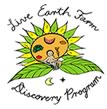 Mothers, fathers, grandparents, caretakers of any kind... bring the babe in your arms to experience the diversity of our beautiful organic farm here in Watsonville. We will use our five senses to get to know the natural world around us. The farm is home to over 50 different fruits and vegetables, chicks, chickens, goats, piglets, and the many wild members of the Pajaro watershed. Mothers, fathers, grandparents, caretakers of any kind... bring the babe in your arms to experience the diversity of our beautiful organic farm here in Watsonville. We will use our five senses to get to know the natural world around us. The farm is home to over 50 different fruits and vegetables, chicks, chickens, goats, piglets, and the many wild members of the Pajaro watershed.
For more information, contact Jessica at the LEFDP office: (831) 728-2032 or email her at lefeducation@baymoon.com.

Happy Girl Kitchen's 2010 Workshop Schedule at LEF
(all workshops are from 10am to 3pm and include an organic lunch, as well as take-home items from what is made that day!)
March 6 (Saturday) - Fermentation (sauerkraut, kimchee and kombucha)
April 10 (Saturday) - Cheese and kefir
June 6 (Sunday) - Cherries and Spring Berries
July 10 (Saturday) - Apricots, strawberries and blackberries
September 12 (Sunday) - Heirloom tomatoes
October 2 (Saturday) - Pickles
Contact Jordan if you have any questions
jordan@happygirlkitchen.com
http://www.happygirlkitchen.com
Art on the Farm Summer Day Camp!
July 12th - 16th
click here for more information
Community Farm Days Schedule
(All Community Farm Days are Saturdays unless otherwise noted.)
March 20 - Sheep to Shawl
May 29 - Three sisters planting in the field! Help sow pumpkins, corn, and beans (update 5/24: see Event Schedule in Week 9 newsletter)
June 19 - Summer Solstice Celebration and Strawberry U-pick
July 3 - Apricot and Strawberry U-pick CANCELLED.
July 12 thru 16 - Summer Celebration Art on the Farm Day Camp!
Aug 28 - Totally tomatoes. From farm to fork, cooking with tomatoes and making farm-fresh cheese. Also U-pick raspberry and tomato day!
Sept 25 - LEFDP Second Annual Fundraiser
Oct 23 - Harvest Celebration and Apple U-pick
|
|